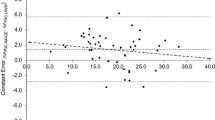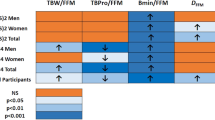Abstract
Background/Objectives:
We intended to (i) to compare the composition of weight loss and weight gain using densitometry, deuterium dilution (D2O), dual-energy X-ray absorptiometry (DXA), magnetic resonance imaging (MRI) and the four-compartment (4C) model and (ii) to compare regional changes in fat mass (FM), fat-free mass (FFM) and skeletal muscle as assessed by DXA and MRI.
Subjects/Methods:
Eighty-three study participants aged between 21 and 58 years with a body mass index range of 20.2–46.8 kg/m2 had been assessed at two different occasions with a mean follow-up between 23.5 and 43.5 months. Body-weight changes within < 3% were considered as weight stable, a gain or a loss of >3% of initial weight was considered as a significant weight change.
Results:
There was a considerable bias between the body-composition data obtained by the individual methods. When compared with the 4C model, mean bias of D2O and densitometry was explained by the erroneous assumption of a constant hydration of FFM, thus, changes in FM were underestimated by D2O but overestimated by densitometry. Because hydration does not normalize after weight loss, all two-component models have a systematic error in weight-reduced subjects. The bias between 4C model and DXA was mainly explained by FM% at baseline, whereas FFM hydration contributed to additional 5%. As to the regional changes in body composition, DXA data had a considerable bias and, thus, cannot replace MRI.
Conclusions:
To assess changes in body composition associated with weight changes, only the 4C model and MRI can be used with confidence.
This is a preview of subscription content, access via your institution
Access options
Subscribe to this journal
Receive 12 print issues and online access
$259.00 per year
only $21.58 per issue
Buy this article
- Purchase on Springer Link
- Instant access to full article PDF
Prices may be subject to local taxes which are calculated during checkout



Similar content being viewed by others
References
Van Gaal LF, Mertens IL, De Block CE . Mechanisms linking obesity with cardiovascular disease. Nature 2006; 444: 875–880.
Heitmann BL, Garby L . Composition (lean and fat tissue) of weight changes in adult Danes. Am J Clin Nutr 2002; 75 (5), 840–847.
Mikkelsen KL, Heitmann BL, Keiding N, Sorensen TI . Independent effects of stable and changing body weight on total mortality. Epidemiology 1999; 10 (6), 671–678.
Newman AB, Yanez D, Harris T, Duxbury A, Enright PL, Fried LP et al. Weight change in old age and its association with mortality. J Am Geriatr Soc 2001; 49 (10), 1309–1318.
Newman AB, Lee JS, Visser M, Goodpaster BH, Kritchevsky SB, Tylavsky FA et al. Weight change and the conservation of lean mass in old age: the Health, Aging and Body Composition Study. Am J Clin Nutr 2005; 82: 872–878. quiz 915-6.
Beavers KM, Lyles MF, Davis CC, Wang X, Beavers DP, Nicklas BJ . Is lost lean mass from intentional weight loss recovered during weight regain in postmenopausal women? Am J Clin Nutr 2011; 94: 767–774.
Ritz P, Salle A, Audran M, Rohmer V . Comparison of different methods to assess body composition of weight loss in obese and diabetic patients. Diabetes Res Clin Pract 2007; 77: 405–411.
Van Wye G, Dubin JA, Blair SN, Di Pietro L . Weight cycling and 6-year weight change in healthy adults: the Aerobics Center Longitudinal Study. Obesity 2007; 15: 731–739.
Mason C, Foster-Schubert KE, Imayama I, Xiao L, Kong A, Campbell KL et al. History of weight cycling does not impede future weight loss or metabolic improvements in postmenopausal women. Metabolism 2012; 62: 127–136.
Hensrud DD, Weinsier RL, Darnell BE, Hunter GR . A prospective-study of weight maintenance in obese subjects reduced to normal body-weight without weight-loss training. Am J Clin Nutr 1994; 60: 688–694.
Gately PJ, Radley D, Cooke CB, Carroll S, Oldroyd B, Truscott JG et al. Comparison of body composition methods in overweight and obese children. J Appl Physiol 2003; 95: 2039–2046.
Baumgartner RN, Heymsfield SB, Lichtman S, Wang J, Pierson RN . Body composition in elderly people: effect of criterion estimates on predictive equations. Am J Clin Nutr 1991; 53: 1345–1353.
Korth O, Bosy-Westphal A, Zschoche P, Gluer CC, Heller M, Muller MJ . Influence of methods used in body composition analysis on the prediction of resting energy expenditure. Eur J Clin Nutr 2007; 61: 582–589.
Minderico CS, Silva AM, Keller K, Branco TL, Martins SS, Palmeira AL et al. Usefulness of different techniques for measuring body composition changes during weight loss in overweight and obese women. Br J Nutr 2008; 99: 432–441.
Tchoukalova YD, Koutsari C, Karpyak MV, Votruba SB, Wendland E, Jensen MD . Subcutaneous adipocyte size and body fat distribution. Am J Clin Nutr 2008; 87: 56–63.
Coin A, Giannini S, Minicuci N, Rinaldi G, Pedrazzoni M, Minisola S et al. Limb fat-free mass and fat mass reference values by dual-energy X-ray absorptiometry (DEXA) in a 20–80 year-old Italian population. Clin Nutr 2012; 31: 506–511.
Lee JS, Visser M, Tylavsky FA, Kritchevsky SB, Schwartz AV, Sahyoun N et al. Weight loss and regain and effects on body composition: the Health, Aging, and Body Composition Study. J Gerontol A Biol Sci Med Sci 2010; 65: 78–83.
St-Onge MP, Gallagher D . Body composition changes with aging: the cause or the result of alterations in metabolic rate and macronutrient oxidation? Nutrition 2010; 26: 152–155.
Stevens J, Truesdale KP, McClain JE, Cai J . The definition of weight maintenance. Int J Obes (Lond) 2006; 30: 391–399.
Siri WE . Body composition from fluid spaces and density: analysis of methods. 1961. Nutrition 1993; 9 (5), 480–491. discussion, 92.
Fuller NJ, Jebb SA, Laskey MA, Coward WA, Elia M . Four-component model for the assessment of body composition in humans: comparison with alternative methods, and evaluation of the density and hydration of fat-free mass. Clin Sci 1992; 82: 687–693.
Brozek J, Grande F, Anderson JT, Keys A . Densitometric analysis of body composition: revision of some quantitative assumptions. Ann N Y Acad Sci 1963; 110: 113–140.
Bosy-Westphal A, Kossel E, Goele K, Blocker T, Lagerpusch M, Later W et al. Association of pericardial fat with liver fat and insulin sensitivity after diet-induced weight loss in overweight women. Obesity 2010; 18: 2111–2117.
Later W, Bosy-Westphal A, Kossel E, Gluer CC, Heller M, Muller MJ . Is the 1975 Reference Man still a suitable reference? Eur J Clin Nutr 2010; 64: 1035–1042.
Snyder WS CM, Nasset ES, Karhausen LR, Howells GP, Tipton IH Report of the Task Group on Reference Man. Pergamon Press: Oxford, New York, USA, 1975.
Bland JM, Altman DG . Statistical methods for assessing agreement between two methods of clinical measurement. Int J Nurs Stud 2010; 47: 931–936.
Schoeller DA, Tylavsky FA, Baer DJ, Chumlea WC, Earthman CP, Fuerst T et al. QDR 4500A dual-energy X-ray absorptiometer underestimates fat mass in comparison with criterion methods in adults. Am J Clin Nutr 2005; 81: 1018–1025.
Nakata Y, Tanaka K, Mizuki T, Yoshida T . Body composition measurements by dual-energy X-ray absorptiometry differ between two analysis modes. J Clin Densitom 2004; 7: 443–447.
Jebb SA . Measurement of soft tissue composition by dual energy X-ray absorptiometry. Br J Nutr 1997; 77: 151–163.
Williams JE, Wells JC, Wilson CM, Haroun D, Lucas A, Fewtrell MS . Evaluation of Lunar Prodigy dual-energy X-ray absorptiometry for assessing body composition in healthy persons and patients by comparison with the criterion 4-component model. Am J Clin Nutr 2006; 83: 1047–1054.
Wang Z, Deurenberg P, Wang W, Pietrobelli A, Baumgartner RN, Heymsfield SB . Hydration of fat-free body mass: review and critique of a classic body-composition constant. Am J Clin Nutr 1999; 69: 833–841.
Lohman T . Human Body Composition. In: Heymsfield SB LST, Wang Z, (eds). Human Body Composition 2nd edn pp 63–78, Human Kinetics: Springfield, IL, USA, 2005.
Roemmich JN, Clark PA, Weltman A, Rogol AD . Alterations in growth and body composition during puberty I. Comparing multicompartment body composition models. J Appl Physiol 1997; 83: 927–935.
Fields DA, Goran MI . Body composition techniques and the four-compartment model in children. J Appl Physiol 2000; 89: 613–620.
Chumlea WC, Schubert CM, Sun SS, Demerath E, Towne B, Siervogel RM . A review of body water status and the effects of age and body fatness in children and adults. J Nutr Health Aging 2007; 11: 111–118.
Chumlea WC . Body composition assessment of obesity. In: RD Bray GA, (eds). Overweight and the metabolic syndrome. from bench to bedside New York. Springer: New York, 2006; 23–35.
Das SK, Roberts SB, Kehayias JJ, Wang J, Hsu LK, Shikora SA et al. Body composition assessment in extreme obesity and after massive weight loss induced by gastric bypass surgery. Am J Physiol Endocrinol Metab 2003; 284: E1080–E1088.
Fields DA, Wilson GD, Gladden LB, Hunter GR, Pascoe DD, Goran MI . Comparison of the BOD POD with the four-compartment model in adult females. Med Sci Sports Exerc 2001; 33: 1605–1610.
Gallagher D, Ruts E, Visser M, Heshka S, Baumgartner RN, Wang J et al. Weight stability masks sarcopenia in elderly men and women. Am J Physiol Endocrinol Metab 2000; 279: E366–E375.
Forbes GB . Longitudinal changes in adult fat-free mass: influence of body weight. Am J Clin Nutr 1999; 70: 1025–1031.
Bosy-Westphal A, Schautz B, Lagerpusch M, Pourhassan M, Braun W, Goele K . Effect of weight loss and regain on adipose tissue distribution, composition of lean mass, and resting energy expenditure in young overweight and obese adults. Int J Obesity. 2013, e-pub ahead of print, 5 February 2013 doi:10.1038/ijo.2013.1.
Kyle UG, Zhang FF, Morabia A, Pichard C. . Longitudinal study of body composition changes associated with weight change and physical activity. Nutrition 2006; 22: 1103–1111.
Acknowledgements
The authors wish to thank Britta Jux, Klinik für Radiologische Diagnostik, UKSH Kiel, for their help in MRI scanning. The study was funded by Deutsche Forschungsgemeinschaft (DFG Mü 714/ 8-3) BMBF Kompetenznetz Adipositas, Core domain “Body composition” (Körperzusammensetzung; FKZ 01GI1125)
Disclosure
The sponsor of the study (DFG, BMBF) had no role in study design, the collection, analysis and the interpretation of the data, writing the text or in the decision to submit the manuscript.
Author contributions
ABW and MJM designed and supervised the study, ABW, MP and MJM wrote the final version of the manuscript, MJM and ABW had primary responsibility for the final content of the manuscript. ABW and WL performed all the investigations. BS, WL, MP organized the study, collected the data, did the segmentations of whole body MRI data and performed the statistical analyses. C-CG was responsible for DXA and MRI examinations.
Author information
Authors and Affiliations
Corresponding author
Ethics declarations
Competing interests
The authors declare no conflict of interest.
Rights and permissions
About this article
Cite this article
Pourhassan, M., Schautz, B., Braun, W. et al. Impact of body-composition methodology on the composition of weight loss and weight gain. Eur J Clin Nutr 67, 446–454 (2013). https://doi.org/10.1038/ejcn.2013.35
Received:
Accepted:
Published:
Issue Date:
DOI: https://doi.org/10.1038/ejcn.2013.35
Keywords
This article is cited by
-
The impact of disease-related immobilization on thigh muscle mass and strength in older hospitalized patients
BMC Geriatrics (2020)
-
Association between fat mass, adipose tissue, fat fraction per adipose tissue, and metabolic risks: a cross-sectional study in normal, overweight, and obese adults
European Journal of Clinical Nutrition (2019)
-
Impact of weight loss-associated changes in detailed body composition as assessed by whole-body MRI on plasma insulin levels and homeostatis model assessment index
European Journal of Clinical Nutrition (2017)



